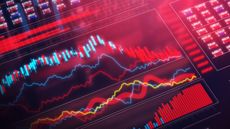Kiplinger's GDP Outlook: Economic Growth Slows to Normal
The economy’s quarterly growth rate will likely average 2% from now on.

Kiplinger’s Economic Outlooks are written by the staff of our weekly Kiplinger Letter and are unavailable elsewhere. Click here for a free issue of The Kiplinger Letter or to subscribe for the latest trends and forecasts from our highly experienced Kiplinger Letter team.
First-quarter GDP growth of 1.6% isn’t as bad as it looks.
First, the economy had exceeded its speed limit in the third and fourth quarters last year, so a slowing was expected. Goods spending, for example, had been on a tear and couldn’t keep up that pace for long. Second, most of the reason for the slowdown from the fourth quarter’s 3.4% GDP expansion was that imports picked up, which happens when domestic demand is strong. In fact, domestic demand grew 2.8% in the first quarter, down only a little from 3.6% the previous quarter. When imports rise, that subtracts from GDP growth. Finally, we expected that economic growth would slow to a more normal rate, which is about 2%. The economy’s potential growth rate in the long run is dependent on productivity growth and labor force growth, and those two factors point to a roughly 2% long-term growth pattern.
Consumer purchases of services picked up in the first quarter, rising at a 4% clip. Home construction grew strongly, while business purchases of equipment rose for the first time after two down quarters. There was some pullback: Spending on business structures was unchanged after a year of strong growth, and businesses cut back additions to their inventories of goods. Business spending will likely stay at the current modest rate because of high interest rates and tight bank lending standards.

Sign up for Kiplinger’s Free E-Newsletters
Profit and prosper with the best of expert advice on investing, taxes, retirement, personal finance and more - straight to your e-mail.
Profit and prosper with the best of expert advice - straight to your e-mail.
Federal government spending also was nearly unchanged. Federal outlays are expected to gradually ebb, as previous spending programs funded by Congress run their course. State and local governments have been hiring because they are still catching up after the pandemic, but they will start to cut back as their staffing approaches normal levels.
Hot inflation in the first quarter will likely delay interest rate cuts that the Federal Reserve might be contemplating. The Fed has been focusing on the Personal Consumption Expenditures price deflator, excluding food and energy, more than the Consumer Price Index (CPI), but this alternate price measure has simply confirmed the CPI’s elevated recent readings.
Yearly average GDP growth for 2024 will be 2.5%, the same as in 2023, but will then slow down to 1.9% in 2025.
Source: Department of Commerce: GDP Data
Read more

To continue reading this article
please register for free
This is different from signing in to your print subscription
Why am I seeing this? Find out more here

David is both staff economist and reporter for The Kiplinger Letter, overseeing Kiplinger forecasts for the U.S. and world economies. Previously, he was senior principal economist in the Center for Forecasting and Modeling at IHS/GlobalInsight, and an economist in the Chief Economist's Office of the U.S. Department of Commerce. David has co-written weekly reports on economic conditions since 1992, and has forecasted GDP and its components since 1995, beating the Blue Chip Indicators forecasts two-thirds of the time. David is a Certified Business Economist as recognized by the National Association for Business Economics. He has two master's degrees and is ABD in economics from the University of North Carolina at Chapel Hill.
-
 Your Venice Day Trip Is Now Slightly More Expensive
Your Venice Day Trip Is Now Slightly More ExpensivePeople visiting Venice for a day will pay a fee for a limited time as part of pilot program.
By Alexandra Svokos Published
-
 Stock Market Today: Markets Tumble Amid Slower Economic Growth and Rising Prices
Stock Market Today: Markets Tumble Amid Slower Economic Growth and Rising PricesDisappointing readings on GDP and inflation helped tank equities.
By Dan Burrows Published
-
 A Spotlight on the Pacific States: The Kiplinger Letter
A Spotlight on the Pacific States: The Kiplinger LetterThe Kiplinger Letter Most Pacific states are seeing good job growth in multiple sectors including tourism, hospitality, and construction.
By David Payne Published
-
 The Robots Are Coming... But Not For a While
The Robots Are Coming... But Not For a WhileThe Kiplinger Letter There’s excitement in the tech sector over the potential of humanoid robots, but widespread adoption is likely to be years away.
By John Miley Published
-
 Farmers Face Another Tough Year As Costs Continue to Climb: The Kiplinger Letter
Farmers Face Another Tough Year As Costs Continue to Climb: The Kiplinger LetterThe Kiplinger Letter Farm income is expected to decline for a second year, while costs continue to up-end farm profitability.
By Matthew Housiaux Published
-
 A Spotlight on the Mountain States: The Kiplinger Letter
A Spotlight on the Mountain States: The Kiplinger LetterThe Kiplinger Letter Most Mountain states are seeing good job growth in multiple sectors from healthcare, energy, and semiconductor production to farming and government.
By David Payne Last updated
-
 A Spotlight on the Plains States: The Kiplinger Letter
A Spotlight on the Plains States: The Kiplinger LetterThe Kiplinger Letter The labor market is tight in the Plains states and outside of healthcare and construction most sectors are flat or down.
By David Payne Published
-
 Kiplinger's Commodities Forecast
Kiplinger's Commodities ForecastThe Kiplinger Letter Following a rocky few years for markets, we expect commodities to be less volatile in 2024, as a post-pandemic normal finally emerges.
By Matthew Housiaux Published
-
 Growth Stalls in China As Property Market Continues to Struggle: The Kiplinger Letter
Growth Stalls in China As Property Market Continues to Struggle: The Kiplinger LetterThe Kiplinger Letter The property market remains a major drag on Chinese growth, with sales now 50% below their peak.
By Rodrigo Sermeño Published
-
 A Spotlight on the South Central States: The Kiplinger Letter
A Spotlight on the South Central States: The Kiplinger LetterThe Kiplinger Letter Outside of the tech sector slump, job growth in the South Central states remains buoyant, with healthcare, construction and business investment going strong.
By David Payne Published